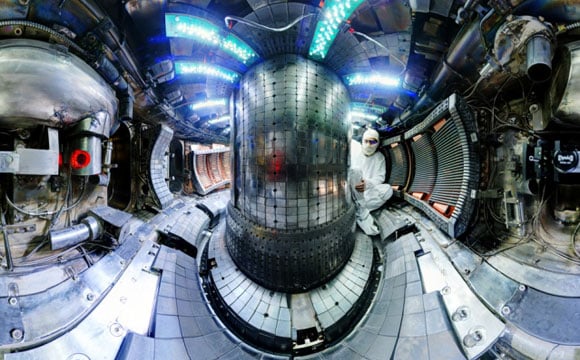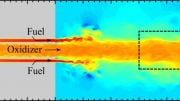
The interior of the fusion experiment Alcator C-Mod at MIT recently broke the plasma pressure record for a magnetic fusion device. The interior of the donut-shaped device confines plasma hotter than the interior of the sun, using high magnetic fields. Postdoc Ted Golfinopoulos, shown here, is performing maintenance between plasma campaigns.
MIT’s Alcator C-Mod tokamak nuclear fusion reactor set a new world record, achieving over 2 atmospheres of pressure for the first time.
On Friday, September 30, at 9:25 p.m. EDT, scientists and engineers at MIT’s Plasma Science and Fusion Center made a leap forward in the pursuit of clean energy. The team set a new world record for plasma pressure in the Institute’s Alcator C-Mod tokamak nuclear fusion reactor. Plasma pressure is the key ingredient to producing energy from nuclear fusion, and MIT’s new result achieves over 2 atmospheres of pressure for the first time.
Alcator leader and senior research scientist Earl Marmar will present the results at the International Atomic Energy Agency Fusion Energy Conference, in Kyoto, Japan, on October 17.
Nuclear fusion has the potential to produce nearly unlimited supplies of clean, safe, carbon-free energy. Fusion is the same process that powers the sun, and it can be realized in reactors that simulate the conditions of ultrahot miniature “stars” of plasma — superheated gas — that are contained within a magnetic field.
For over 50 years it has been known that to make fusion viable on the Earth’s surface, the plasma must be very hot (more than 50 million degrees), it must be stable under intense pressure, and it must be contained in a fixed volume. Successful fusion also requires that the product of three factors — a plasma’s particle density, its confinement time, and its temperature — reaches a certain value. Above this value (the so-called “triple product”), the energy released in a reactor exceeds the energy required to keep the reaction going.
Nuclear fusion has the potential to produce nearly unlimited supplies of clean, safe, carbon-free energy. This 360-degree tour provides look at MIT’s recently deactivated Alcator C-Mod tokamak nuclear fusion reactor, which set a world pressure record on its final day of operation.
Pressure, which is the product of density and temperature, accounts for about two-thirds of the challenge. The amount of power produced increases with the square of the pressure — so doubling the pressure leads to a fourfold increase in energy production.
During the 23 years Alcator C-Mod has been in operation at MIT, it has repeatedly advanced the record for plasma pressure in a magnetic confinement device. The previous record of 1.77 atmospheres was set in 2005 (also at Alcator C-Mod). While setting the new record of 2.05 atmospheres, a 15 percent improvement, the temperature inside Alcator C-Mod reached over 35 million degrees Celsius, or approximately twice as hot as the center of the sun. The plasma produced 300 trillion fusion reactions per second and had a central magnetic field strength of 5.7 tesla. It carried 1.4 million amps of electrical current and was heated with over 4 million watts of power. The reaction occurred in a volume of approximately 1 cubic meter (not much larger than a coat closet) and the plasma lasted for two full seconds.
Other fusion experiments conducted in reactors similar to Alcator have reached these temperatures, but at pressures closer to 1 atmosphere; MIT’s results exceeded the next highest pressure achieved in non-Alcator devices by approximately 70 percent.
While Alcator C-Mod’s contributions to the advancement of fusion energy have been significant, it is a science research facility. In 2012 the DOE decided to cease funding to Alcator due to budget pressures from the construction of ITER. Following that decision, the U.S. Congress restored funding to Alcator C-Mod for a three-year period, which ended on September 30.
“This is a remarkable achievement that highlights the highly successful Alcator C-Mod program at MIT,” says Dale Meade, former deputy director at the Princeton Plasma Physics Laboratory, who was not directly involved in the experiments. “The record plasma pressure validates the high-magnetic-field approach as an attractive path to practical fusion energy.”
“This result confirms that the high pressures required for a burning plasma can be best achieved with high-magnetic-field tokamaks such as Alcator C-Mod,” says Riccardo Betti, the Robert L. McCrory Professor of Mechanical Engineering and Physics and Astronomy at the University of Rochester.
Alcator C-Mod is the world’s only compact, high-magnetic-field fusion reactor with advanced shaping in a design called a tokamak (a transliteration of a Russian word for “toroidal chamber”), which confines the superheated plasma in a donut-shaped chamber. C-Mod’s high-intensity magnetic field — up to 8 tesla, or 160,000 times the Earth’s magnetic field — allows the device to create the dense, hot plasmas and keep them stable at more than 80 million degrees. Its magnetic field is more than double what is typically used in other designs, which quadruples its ability to contain the plasma pressure.
C-Mod is third in the line of high-magnetic-field tokamaks, first advocated by MIT physics professor Bruno Coppi, to be built and operated at MIT. Ron Parker, a professor of electrical engineering and computer science, led its design phase. Professor Ian Hutchinson of the Department of Nuclear Science and Engineering led its construction and the first 10 years of operation through 2003.
Unless a new device is announced and constructed, the pressure record just set in C-Mod will likely stand for the next 15 years. ITER, a tokamak currently under construction in France, will be approximately 800 times larger in volume than Alcator C-Mod, but it will operate at a lower magnetic field. ITER is expected to reach 2.6 atmospheres when in full operation by 2032, according to a recent Department of Energy report.
Alcator C-Mod is also similar in size and cost to nontokamak magnetic fusion options being pursued by private fusion companies, though it can achieve pressures 50 times higher. “Compact, high-field tokamaks provide another exciting opportunity for accelerating fusion energy development, so that it’s available soon enough to make a difference to problems like climate change and the future of clean energy — goals I think we all share,” says Dennis Whyte, the Hitachi America Professor of Engineering, director of the Plasma Science and Fusion Center, and head of the Department of Nuclear Science and Engineering at MIT.
These experiments were planned by the MIT team and collaborators from other laboratories in the U.S. — including the Princeton Plasma Physics Laboratory, the Oak Ridge National Laboratory, and General Atomics — and conducted on the Alcator C-Mod’s last day of operation. The Alcator C-Mod facility, which officially closed after 23 years of operation on September 23, leaves a profound legacy of collaboration. The facility has contributed to more than 150 PhD theses and dozens of interinstitutional research projects.
To understand how Alcator C-Mod’s design principles could be applied to power generation, MIT’s fusion group is working on adapting newly available high-field, high-temperature superconductors that will be capable of producing magnetic fields of even greater strength without consuming electricity or generating heat. These superconductors are a central ingredient of a conceptual pilot plant called the Affordable Robust Compact (ARC) reactor, which could generate up to 250 million watts of electricity.
Scientists, students, and faculty from the Alcator C-Mod team will discuss fusion, the pressure record, Alcator C-Mod, and the high-field approach at an Ask Me Anything Session on Reddit on Thursday, October 20, at 1 p.m. EDT.









Gooood!!!!!!!!!!
Nikola Tesla showed mankind 100 years ago how to produce all the clean, sustainable, energy needed to do anything at extremely low cost. Big Oil and our own government is keeping this knowledge tucked away. No doubt it has been developed by the government and is in its use. Any inventors who seem to be a threat to vested interests are stopped. All this fusion stuff is merely a way to allow the continued control and commodification of energy.
OK, I don’t care if your magnetics are made of any material that superconductors, in saying that they will consume no electricity merely because they are superconducting is a lie. Lets be honest here. The power is lost not by wire resistance because they super-conduct. OK, we get that, BUT there is still a magnetic field being maintained which represents a load on the electrical system because the power is transferred from electrical current into a magnetic field and that radiates out into the environment and is lost to heating of metallic materials nearby in form of induction and this field strength must be regulated and maintained so it will still use significant amounts of electricity. Wire resistance loss would be perhaps insignificant compared to the loss of power used in creating a magnetic field that is not recaptured and turned back into electricity by a secondary coil like in a transformer but is instead lost into Eddie currents into the surrounding conductive materials and associated inductive heating of materials etc and you still have to cool the magnetic wires with super cooling systems as well, yet another required associated use of electricity too to keep the materials super conducting instead of super-melting. SO don’t pretend there will ever be a time when you can write-off power usage of the plant itself due to any efficiency improvements here or there. There is not and never will be completely”free energy” where we don’t burn something up in the attempt to produce energy at the same time. The law of thermodynamics should clue you into the fact that just is not possible. Even fusion power burns fuel to create the immense heat that makes power albeit more slowly than any fission plant. And even as efficient as that is, it too runs out at some point, the plant itself requires constant shut-downs and high maintenance to continue to operate because of the huge forces at work containing the huge forces in play. This is all quite costly. Frankly, I don’t think its worth the cost or the unreliable state of production and downtime for maintenance when we can waste less time designing, time building, time permitting, time inspecting, money, and environmental destruction overall mining exotic materials etc to produce conventional renewable power plants which are more predictable, don’t require other power plants to jump start them, and scale up and down so that we don’t require more mega power-lines Cris-crossing our lands and igniting more terrible forrest fires like the recent two in California. Energy needs to be decentralized. This centralized nonsense is at the heart of too many problems we have now with power efficiency, grid reliability, environmental protection, terrorist targets, etc. This is really not the answer we need. We already have the answers in our hands, and the costs and unknown risks of mega-incidents due to failures are known to be less than this no matter how much you want to say this is safer than its conventional counterparts in the nuclear industry. It is still attempting to contain something that is millions of degrees hot, which if suddenly unleashed due to a field collapse can can cause explosions or fires if not completely contained due to wrongly maintained, incorrectly shut down, sudden coolant loss and failure, etc. Don’t deny that it too has some significant risks. Are they really worth it? Nobody has tested these by inducing intentional sudden cooling or containment system failures to see what exactly will happen yet have they under sustained fusion reaction?
Matt, I don’t think anyone thinks that a fusion device can ultimately run without energy input. The ITER tokamak hopes to yield 5 times as much energy than that required to run it, and the total energy will come from the fusion of hydrogen nuclei to helium. In order to reduce the temperture and pressure needed, the heavier isotopes of hydrogen deuterium and tritium each with respecively an extra 1 or 2 neutrons to counter the repulsive force of the hydrogen nuclei.
You are right about the need to decentralise the energy production which would mean smaller power stations, lower transmission losses and more flexibility to stabilise the power supply at make it more reliable. The use of high temperature super conductors will help to reduce the cost of running a fusion reactor.
Dean the flaw with your theory is that if Tesla had done this our military would be using it and by now our enemies would have stolen the technology and congress would be asking why doesnt the civilian sector not have this? Big Oil does not control the defense department which is why most large naval vessels are nuclear powered which eliminates many refueling issues. Refueling is not merely a supply problem its also a logistical problem and anytime the ship has to come into port its a security problem.
try applying oscillating E-M fields tuned to fractions or multiples of resonance frequencies of wave functions of electrons & deuterons & product nuclei
Every bit of energy on this planet comes or came from the sun.